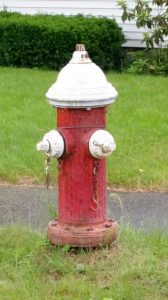WESTFIELD—Following a deadly fire on Park Street Saturday, concerns over fire hydrants and water pressure have come up.
Officials at the Westfield Fire Department have said that the water pressure, while an issue, was not the problem in the deaths of the two residents Saturday. Still, worries have now come from some in the city, after this incident was the second one with reports of hydrant or water issues while battling a fire this year—the other being on Michael Drive. Officials are aware of the problem and are working to try and fix it. However, it can be costly and time-consuming.

A fire hydrant in the area of Park Street. Two people died in a fire over the weekend on Park Street.
According to Director of Public Works David Billips, the problem on Park Street wasn’t due to the hydrants. In fact, according to Assistant Director of Public Works Francis Cain, most of the city’s 3,000-plus hydrants are inspected yearly by the department’s water division, with regulations also suggesting at least one inspection a year.
Instead, it was the sizing of the underground pipes that was suspected in delivering lower water pressure, Billips said.
“It’s like that all the time, it’s not something anyone did wrong,” he said. “It’s a low pressure area with small pipes.”
Billips said that 4-inch pipe feeds 6-inch pipe in the area and the piping is also older in that portion of the city. This older piping can also develop what Cain called “tuberculation,” or a buildup within the pipes. This buildup then causes a further narrowing of the pipes, which then creates an even more restrictive flow and even lower water pressure.
Billips also said that the pressure isn’t impacted by the wells that are currently offline in Westfield, since the pressure comes from the entire system overall.
To solve the problem, there is only one step the city can take, according to Billips.
“You have to replace the pipes, that’s the only way you can fix them,” he said. “There’s nothing you can do to clean them out.”
Billips was unable to specify an amount for what it would cost to replace the older lines within the city, but he said that it could be “millions of dollars” in cost for Westfield.
“You can do it but it’s an incredibly costly fix,” he said. “We’ve identified these things, they are in the capital plan, we just need the money to do them.”
He added that actions have been taken within the city to remedy the problem, like in the Gaslight District.
“We’ve already replaced a lot of the smaller lines, so we continue to work on it,” he said.
Another way to help firefighters that has been suggested is to color code hydrants that the city knows has these issues. Billips said that these would be put into Geographic Information Maps (GIS), which firefighters could use to determine a plan of attack.
In addition, Westfield Fire Chief Mary Regan said that the fire department already takes measures to deal with possible issues, whether it is lack of water pressure or the lack of hydrants. Certain information, such as locations of water sources like fire hydrants and other warnings, are available to officers in the department, according to Regan.
“Those systems are right on the deputy’s vehicle, right on the engines,” she said. “The officers are looking up that information.”

An array of items line a pathway on a portion of the property at 40 Park Street, where one person died and another later died after being transported to Baystate Noble Hospital on Saturday.
And based on what the information is, the department may be preemptive and request additional services from other areas, as well as plan their attack on the fire or incident. Regan did say though, that the information currently does not include static pressure of hydrants, which she said could be helpful.
She also said that in areas where there are no hydrants, the department has other ways to gather water, such as from pools or nearby water sources. This was not an option at the Park Street fire, though.
In the end, Regan said that even with the water issues, other factors played roles in the two fatalities.
“We had some water issues, but the actual problem was making entry into the home so that was difficult,” she said. “We had three engines there, so we had plenty of water.”
Regan said that each engine carries 750 gallons of water.
Entry was difficult, according to Regan, because of the amount of items that were impeding access into the home. In addition, there were no working smoke alarms that could have alerted the victims, Regan said.
“We just can’t stress enough how important it is that they’re working and you have them on every level,” she said of smoke detectors.
Regan added that the request for assistance from the fire department at Barnes Air Reserve for additional water supply was precautionary, and that the fire was limited to one room with severe smoke.

